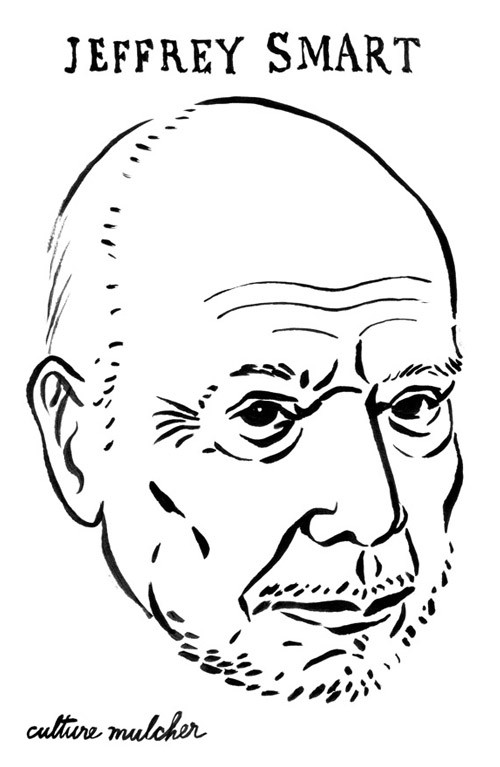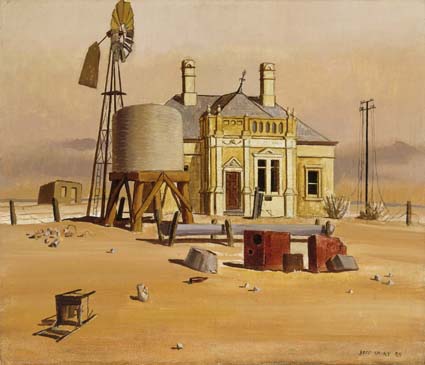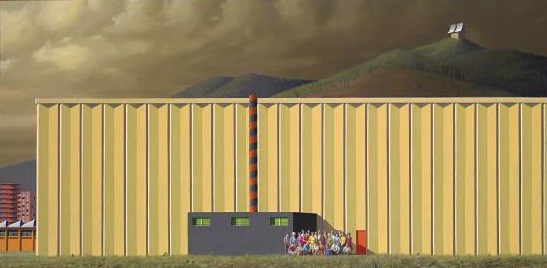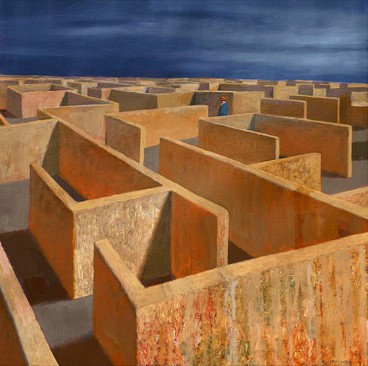One of two reasons we talk about Jeffrey Smart (1921–2013) is that he was one of the last of a famous generation of Australian artists born into a world of full modernism, far-flung from it though we were:
Russell Drysdale (1912–1981); Albert Tucker (1914–1999); Donald Friend (1915–1989); Sidney Nolan (1917–1992); Arthur Boyd (1920–1999); Joy Hester (1920–1960); John Perceval (1923-2000); Margaret Olley (1923–2011); Charles Blackman (1928–); John Olsen (1928–)
And the other is that he was beloved of gallery directors and gallery goers, to paraphrase a friend of mine. As Christopher Allen in the Oz so neatly put it: “There are several jokes about abstraction in Smart’s painting, but the more important implication is that he can give the viewer everything that abstraction can — the colour fields, the flat surfaces and so on — but with all the meaning of the real world as well.”
I had some conversations about his legacy over the weekend, some with artists, and the feeling was moot; the directors and punters may love him, but the cognoscenti are more ambivalent. In my positive notice of Smart’s valedictory survey at Tarrawarra in March, “I mentioned the show to an artist the other day who is working on her PhD. She shocked me by asking how was Smart important to Australian art history. I may not be a big fan of Smart but his oeuvre is of a quality (surely) beyond dispute.” But perhaps she intended her question to be stressed differently: Well, he may be good but is he important to our art?
Smart at 24: The Wasteland II, 1945
Smart at 51: Factory and staff Erehwyna, 1972
Smart’s last, at 90: Labyrinth, 2011
Smart: Stillness and Enchantment
On the ABC Talking Heads in 2009, Smart mentioned “stillness”: “And then [TS Eliot] talks about ‘the stillness of a work of art’. And that’s so crucial. And if you find that in a work of art, like Cezanne, it’s that perfect stillness. And I hope I get it sometimes in my own work.” (Amusingly, the Fairfax obit regards Cezanne as a cubist! — “Highlights included the former home of Cezanne, the cubist painter he greatly admired…”)
In his autobiography, Not Quite Straight, Smart writes: “Many of my paintings have their origin in a passing glance. Something I have seen catches my eye, and I cautiously rejoice because it might be the beginning of a painting. Sometimes it is impossible to stop … and it does happen that when I get back to the place, I wonder what on earth it could have been that enchanted me — it wasn’t there. Enchantment is the word for it.”
From the distilled selection in the “Master of Stillness’ survey at Tarrawarra, Smart was consistent in approach and stuck to his guns through flat and conceptual times. His credo was like a lyric poet’s: to capture a moment and embed it in timeless stillness.
It’s Art, But Did He Succeed?
I’d say on those two criteria he succeeded. But whether he transmits the enchantment of the moment may be a matter of taste. An art writer of my acquaintance remarked that Smart’s “figures are wooden, and his surface dry. He could never produce an appealing finish. But his composition, imagery and colour are masterful.” Which I mostly agree with: Smart’s figures are wooden; his surface is chalky, but I kinda like that; his imagery can be banal — that they are contrived is to say they are theatrical, which fits his bill; and I find his pop-primary colours a bit wearying, but they work well in individual pictures.
Alternately, Doug Hall, Australian Commissioner at the Venice Biennale, wrote crushingly in the Monthly:
“But this colour, that shape – signs, arrows, road lines – it’s obvious and stiff, like a new realist academician going through his paces … The 1970s and ’80s saw Smart consolidate the contrived compositions with their polyurethane figures, as well as his use of colour: those raw primaries, the cadmiums. Smart is interested in colour and yet, at his most garish, he allows them to look as though they’ve been squeezed straight from the tube.”
The PhD candidate’s question, how was Smart important to Australian art history? is picked up when Hall compares Smart unfavorably to John Brack, Sidney Nolan and Fred Williams:
“Yet Brack, Nolan and Williams shaped the way we see Australia. They represent both a sophisticated and vernacular iconography that has and will endure. Is it possible to think of these three ever slipping from any account of Australian art in the second half of the twentieth century?” (Hall’s ironic end remark on his own critique is, “To dissent is rather like joining a queue to kick Skippy.”)
Perversely I give Smart credit for not painting Australia. He lived in Tuscany, and his inspirations were the cities close to him. But those urban landscapes are what most of us are close to, or in, and if the shapes in an Italian city are perfectly familiar to us, that’s a big part of the point. We recognisably live in Smartland, rather more than we live in Fred Williams’ arcadia, or Nolan’s skeleton-strewn red centre or Brack’s final strange scapes of pencils and dummies and cards (to point out that it’s sometimes only a period of an artist’s work we like or value.)
But we don’t have to invidiously compare any of these artists. We can look at what we wish and talk about whom we wish. Hall’s piece may have more to do with what gallery directors put on their walls, and how Smart takes up a lot of air that could be given to less well-known and “better” artists. But the great “general public,” those gallery goers, know what they like to see, too. And they almost never see eye to eye with the cognoscenti.











Crikey is committed to hosting lively discussions. Help us keep the conversation useful, interesting and welcoming. We aim to publish comments quickly in the interest of promoting robust conversation, but we’re a small team and we deploy filters to protect against legal risk. Occasionally your comment may be held up while we review, but we’re working as fast as we can to keep the conversation rolling.
The Crikey comment section is members-only content. Please subscribe to leave a comment.
The Crikey comment section is members-only content. Please login to leave a comment.